Douglas F-10 (F3D) Skyknight: Deck All-weather Interceptor
Although the Skyline aircraft was released in a limited edition, it lived a long, by its standards, career, being in service aviation US Marine Corps for almost 20 years. During its career, this aircraft managed to participate in two major wars. At the same time, he became the first jet aircraft in the world to shoot down another jet aircraft in a night battle. This dogfight took place on November 2, 1952, when a North Korean MiG-3 was shot down by a Douglas F15D Skyknight. It is worth noting that during the years of the Korean War, this American interceptor became the most successful in terms of the number of victories won over enemy aircraft among all carrier-based fighters.
History create
In 1946, the Douglas Advanced Research Department began designing a new all-weather night interceptor, which received the designation Skynight, and E. Heineman supervised the work. The developed fighter-interceptor turned out to be quite large, so it was decided to use two Westinghouse J34-WE-22 turbojet engines, the maximum thrust of these engines was 1360 kgf. The designers of the aircraft tried not to occupy the useful volume of the fuselage by installing a power plant in it, deciding to move the engines into cylindrical nacelles located along the sides of the fuselage. Such a solution made it possible not only to free up the useful internal volume of the fuselage, but also to greatly simplify the process of engine maintenance. They were easily removed and inspected through special rather large hatches located at the bottom of the gondolas.
The front part of the fuselage of the aircraft, which was free from air intakes, as well as the cockpit compartment, was occupied by the AN / APQ 35 radar. Under the antenna of this radar there was a carriage with four 20-mm guns. The spacious and wide cockpit housed the pilot and radar operator. At the same time, it was decided not to put ejection seats on the plane, the interceptor turned out to be quite heavy without it - the weight was more than 9 tons. For this reason, the problem of saving the crew of the aircraft remained open for a long time, until the designers came up with a simple solution to it. Behind the cockpit, it was decided to arrange an inclined tunnel, the entrance to which was closed by the pilots' seats. In the event of an emergency, the pilots turned the seat cups to the sides of the cockpit and opened the tunnel hatch. At the same time, the bottom cover of the tunnel was dropped in the lower part of the fuselage of the aircraft, and the shield was deflected by the hydraulic cylinder, which was supposed to protect the pilots from the flow of oncoming air. After that, the pilots had only to slip out of the fighter-interceptor down.
Tests of the aircraft leaving system were carried out at flight speeds up to 800 km / h and were quite successful. However, throughout the life of these combat vehicles in the operating parts of the pilots did not trust her, fearing to get stuck in a narrow tunnel. In 1956, their doubts came true. The turbine blade of the engine, which had broken off in flight, pierced the interceptor fuselage fuel tank, the fighter flared up, and its crew did not manage to leave the burning Skynight.
Heineman’s well-known passion for reducing the flight weight of his aircraft caused the rejection of the placement of fuel tanks at the ends of the wing, which was the traditional solution for all American 1950 fighters. Thanks to this approach, the designers won the weight of the interceptor wing itself, as well as the weight of its folding mechanism. The designers of the machine also took care of the purity of its aerodynamic forms, hiding all the available antennas flush with the interceptor panel.
The construction of the first prototype fighter-interceptor Douglas F3D "Skynight" was completed at the end of the winter of 1948. In March of the same year, the first prototype of Skynight was rolled out onto the runway of the airfield. The first to lift the car into the air was R. Tav, the chief pilot of the Douglas company. After a series of short tests of the power plant, the car safely took off into the sky. The second prototype of the interceptor took off in June 1948, and the third - in October of the same year.
The first production all-weather Skynight interceptor rolled off the assembly line in February 1950. At the same time, Heinemann slightly improved the performance of his fighter by installing more powerful new J34-WE-34 engines on it (the developed maximum thrust is 1470 kgf). Thanks to these engines, the rate of climb of the aircraft increased by 1 m / s, and the maximum speed - by 50 km / h. At the same time, the high drag of the interceptor did not significantly improve its performance.
Simultaneously with the launch of the F3D-1 fighter modification into mass production, Douglas was preparing to release a new version of the F3D-2, which was supposed to receive the J46-WE-3 turbojet engine (maximum thrust is already 2180 kgf), but delays in the supply of these engines forced production of an aircraft with a J34-WE-36 engine developing a thrust of 1510 kgf. The first serial F3D-2 fighter took to the skies in February 1951. Its main improvement, in addition to new engines, was the G-3 automatic flight control system from General Electric. This system made it possible to fly in all weather conditions, including those with completely abandoned control. A total of 237 aircraft were manufactured in this modification. Serial production of the F3D-2 aircraft was completed in March 1952.
Since January 1947, in order to increase the combat potential of the Skynight interceptor, Sperry has been designing the Sparrow air-to-air guided missile. This rocket was supposed to fully compensate for some "sluggishness" of the F3D fighter. To speed up the process of creating this SD, the Douglas company took over the production of missile bodies. Guidance of the SD on the target was carried out along the radar beam. Flight tests of the new SD started in 1951. After the release of 150 Sparrow missiles, one F3D-1 interceptor fighter was equipped with four underwing pylons. Tests of this version of the fighter were successful. By order of the American fleet Douglas upgraded 12 F3D-1 and 16 F3D-2 fighters to rocket-armed aircraft - F3D-1M and F3D-2M, respectively. Such a small number of modernized machines is explained by the high cost of operating missiles, as well as their lack of reliability.
The main modifications of the Skynight all-weather interceptor were presented in the following versions: F3D-1M (MF-10A) - 12 F3D-1 aircraft after conversion to use Sparrow missiles. The F3D-2B is the only aircraft based on the F3D-2, which was used in 1952 for special weapons testing. F3D-2M (MF-10B) - 16 interceptors converted to use Sparrow missiles. F3D-2Q (EF-10B) - 35 interceptor fighters that were converted into electronic countermeasures aircraft (ECM). F3D-2T - 5 aircraft of the F3D-2 version, which were converted into a night fighter trainer. F3D-2T2 (TF-10B) - 55 interceptors of the F3D-2 version, which were used as training aircraft for radar operators, as well as an electronic warfare aircraft.
Aircraft design
Skyknight is an all-weather night fighter-interceptor, it was a monoplane with a mid-range straight wing and a single tail. The aircraft used a semi-monocoque cylindrical fuselage with a working skin. Inside the fuselage were fuel tanks with a total capacity of 4163 liters and electronic equipment. In the bow, radar antennas were attached to the first power frame, which were covered with a radio-transparent fairing. Further, the forward part of the fuselage was divided into two compartments by a horizontal partition. In the upper, airtight compartment, the cockpit of the aircraft was located, and in the lower there was a gun carriage with four 20-mm guns and a niche for the nose landing gear.
The interceptor's cockpit housed the pilot's and radar operator's seats. In this case, the pilot's seat was located on the right, and the radar operator on the left. The entrance to the cockpit was through a hatch located in the upper part of the binding lantern. To facilitate the landing of pilots in a fighter-interceptor, steps were made on the sides of the fuselage. All panels and instruments in the cockpit were illuminated with diffused red light. The fighter's instrumentation and navigation equipment was considered the most modern at the time the interceptor was built.
Behind the cockpit were placed fuel tanks, as well as blocks of electronic equipment. For the emergency escape of the fighter-interceptor between the pilot's seats was located the hatch of an inclined tunnel. In order to open the hatch, it was necessary to turn the seats, move them back, after which the seat backs would be turned 90 degrees to the sides of the cabin.
Two engine nacelles with engines and a wing spar were attached to the power frames of the middle part of the fuselage of the Skynight fighter-interceptor. In the lower part, between the engine nacelles, there was a hydraulic accumulator, as well as units of the aircraft's hydraulic system. In the tail section there were brake flaps with an area of 1,86 square meters each, they were used to limit the speed of braking and diving. The flap control drive was hydraulic. A keel with a large false keel was fixed on top of the tail section, and an additional tail support with a small wheel and a special brake hook were attached to the bottom. In the last section of the interceptor's fuselage, under a radio-transparent fairing, there was an AN / APS-28 radar antenna designed to view the rear hemisphere.
The wing of the aircraft was two-spar, straight. Wing mechanization included ailerons and slotted flaps. On the modification of the F3D-2 aircraft, spoilers were mounted on the wing surface in front of the ailerons to improve maneuverability. Hydraulic boosters were used to control the ailerons and flaps. On the lower surface of the center section of the fighter-interceptor, cutouts were located under the niches for cleaning the racks of the main landing gear of the aircraft. The chassis was made tricycle, with a nose wheel. All landing gear had one wheel. The system for releasing and retracting the landing gear was hydraulic; in case of emergencies, a pneumatic backup system was used. Chassis wheel braking system - disc, pneumatic.
The aircraft control system is booster, the control wiring is rigid. On all models of the fighter-interceptor, an analog automatic control system (autopilot) G-3 was installed. Beginning in 1957, Skynight interceptors were also equipped with an automatic landing system for an aircraft on an aircraft carrier. This system made it possible to land in simple weather conditions during the day and at night. According to American engineers, even without the participation of the pilot himself.
The F3D-2 interceptor powerplant included two J34-WE-36 turbojet engines, which were suspended in extended nacelles located on the sides of the fuselage. In order to reduce the loss of thrust, exhaust devices were made extremely short. The selection of air necessary for conditioning and sealing the cabin was carried out from the engine compressors.
The armament of the aircraft consisted of 4x20 mm M-12 aircraft guns. On aircraft in the F3D-1M and F3D-2M variants, four SPARROW-1 missiles could be installed. The one-of-a-kind "atomic bomber" F3D-2B was able to carry two conventional or nuclear bombs weighing up to 900 kg each. To increase the flight range of the aircraft, additional fuel tanks, which had a capacity of 1136 liters each, could easily be hung on two internal underwing pylons.
Flight technical characteristics of F3D-2:
Overall dimensions: length - 13,88 m, height - 4,9 m, wingspan - 15,24 m, wing area - 37,16 sq. m.
The mass of the plane is empty - 6813 kg.
Normal take-off weight - 9715 kg.
Maximum take-off weight - 12 151 kg.
The power plant - 2 TRD Westinghouse J34-WE-36, unforced thrust 2x1510 kgf.
The maximum flight speed is 852 km / h.
Cruising flight speed - 731 km / h.
Practical range - 2212 km. with two PTB.
Almost ceiling - 11 200 m.
Armament - 4X20-mm guns (200 projectiles per barrel), combat load - up to 1800 kg on 4-x suspension points: UR "air-to-air", bombs.
Crew - 2 person.
Information sources:
http://www.airwar.ru/enc/fighter/f3d.html
http://avia.cofe.ru/D/D-129.htm
http://voenteh.com/samolety/palubnye-samolety-poslevoennogo-vremeni/duglas-f3d-skainait.html
http://igor113.livejournal.com/582787.html
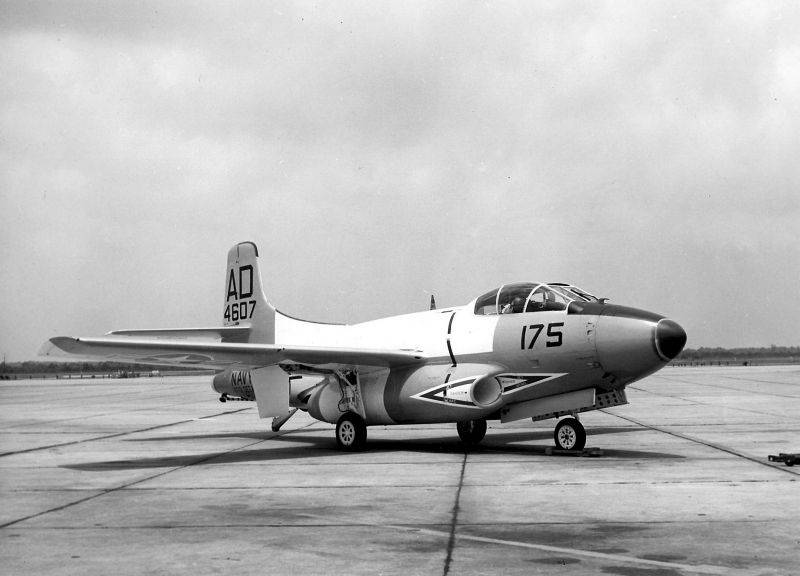
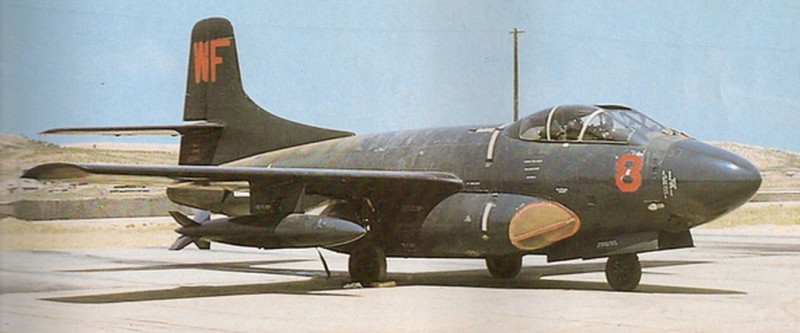
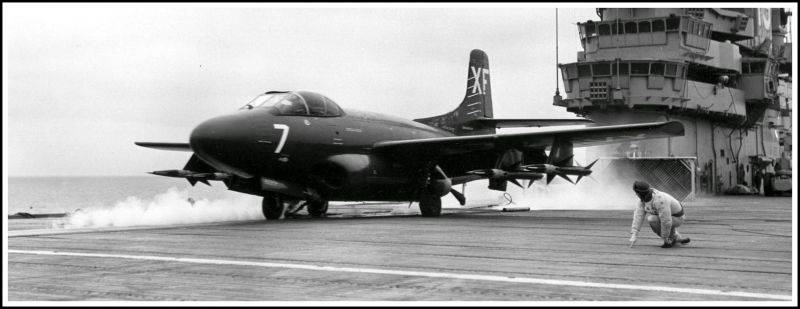
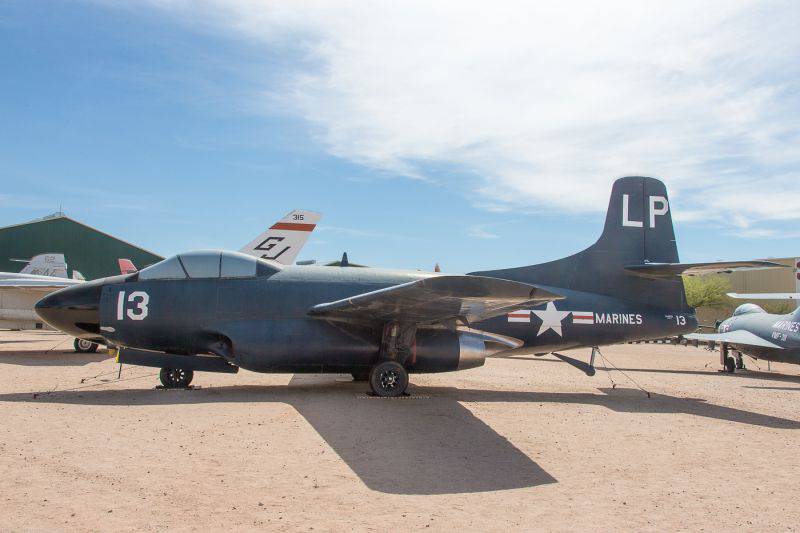
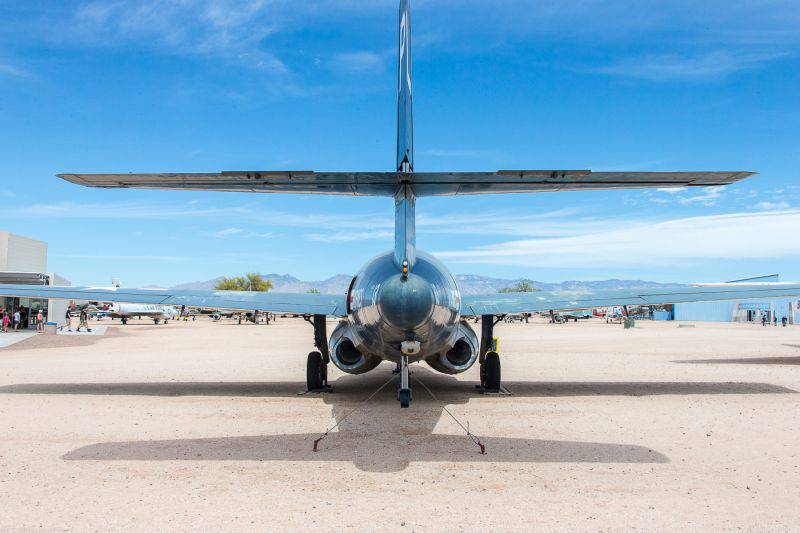
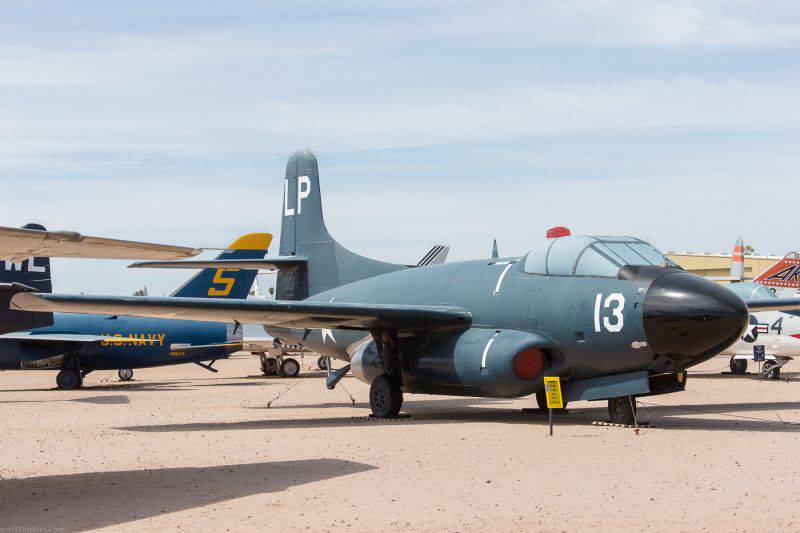
Information